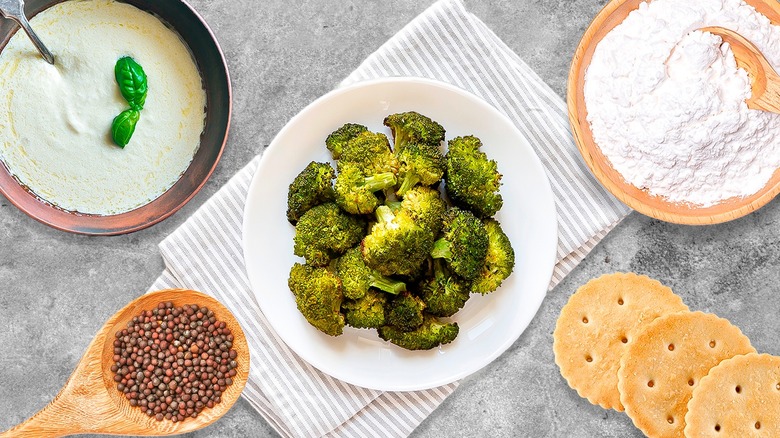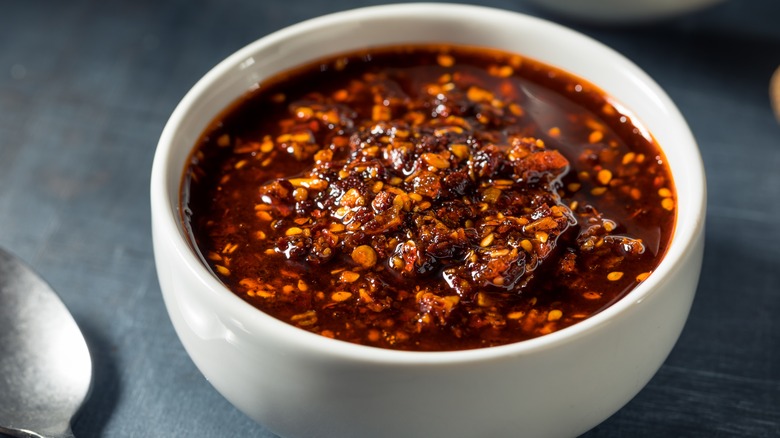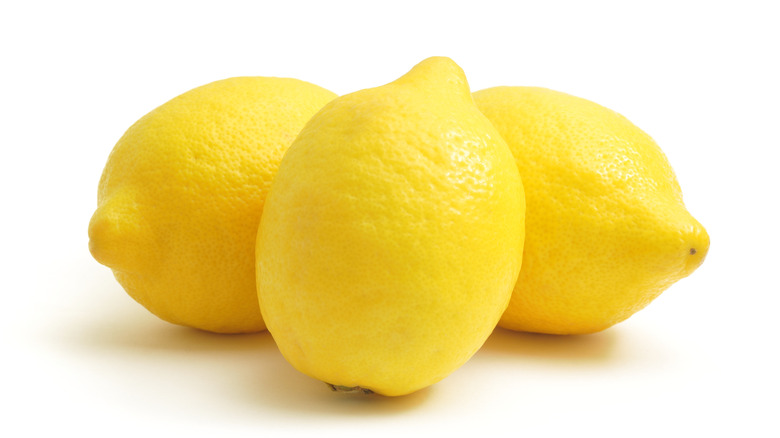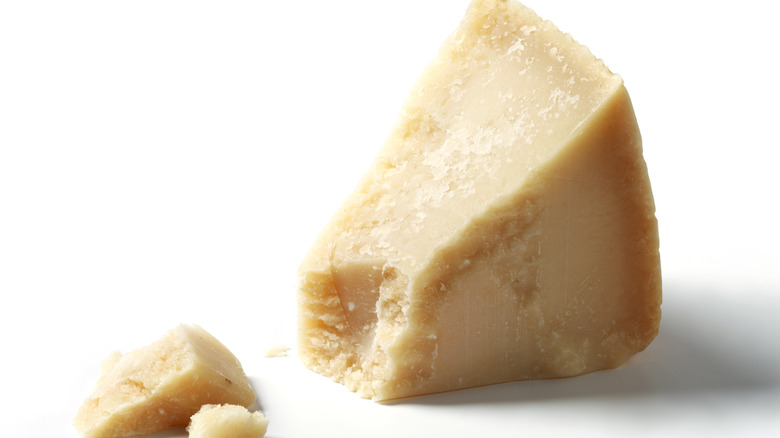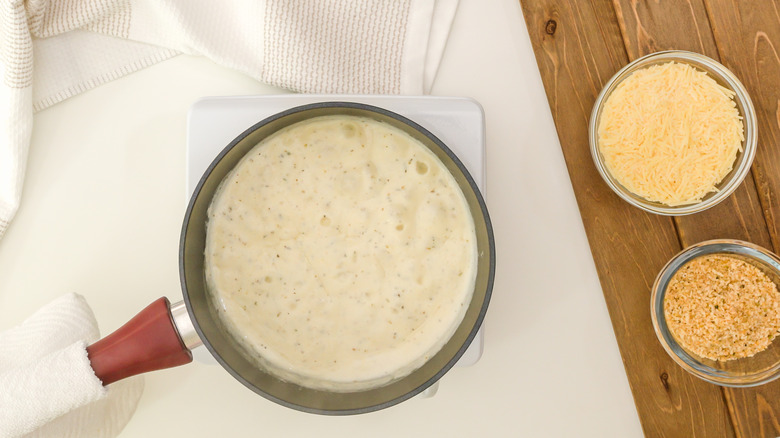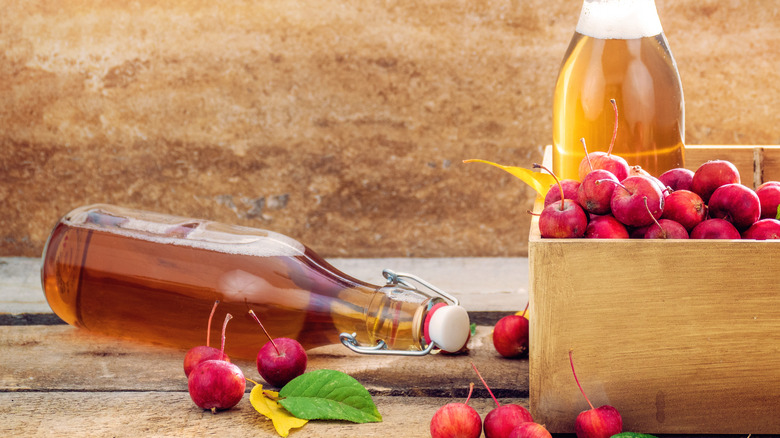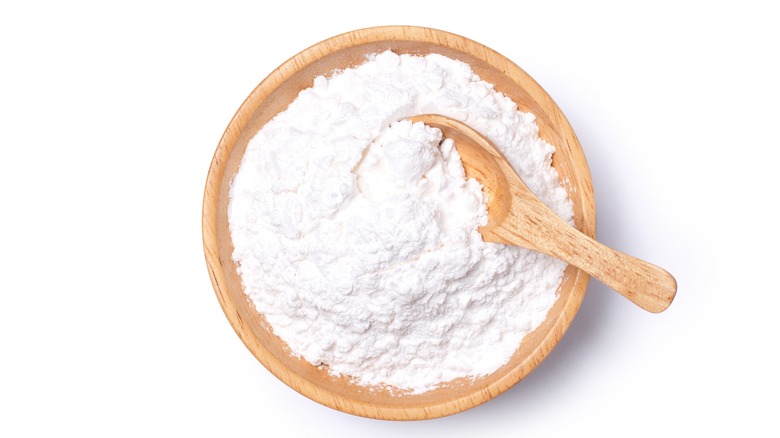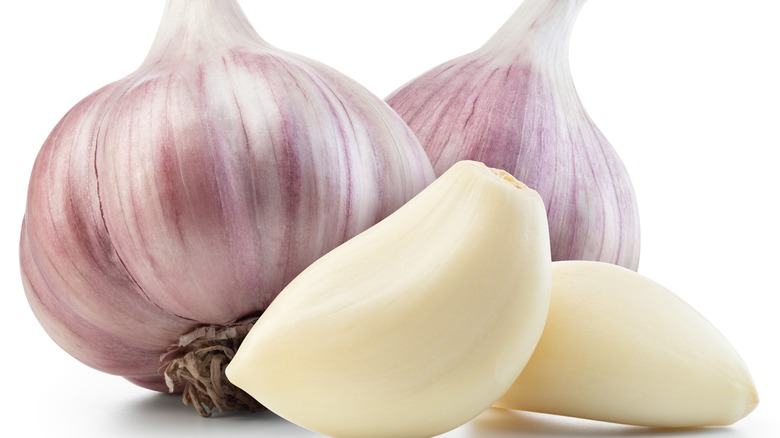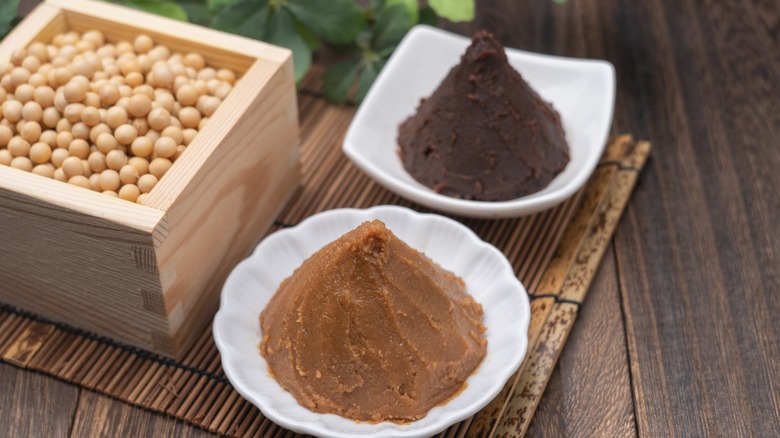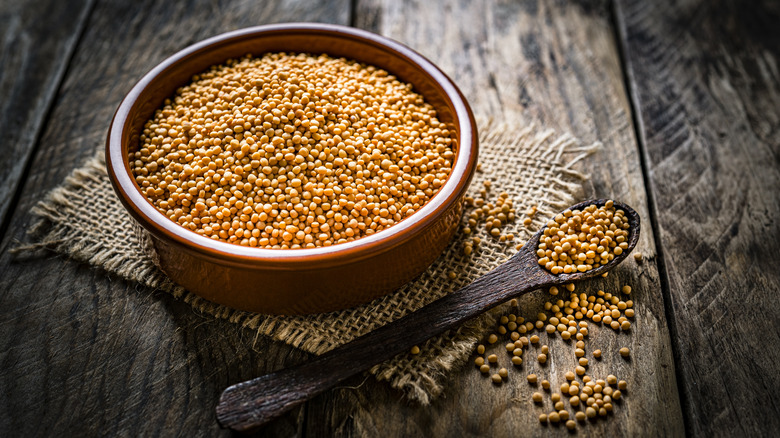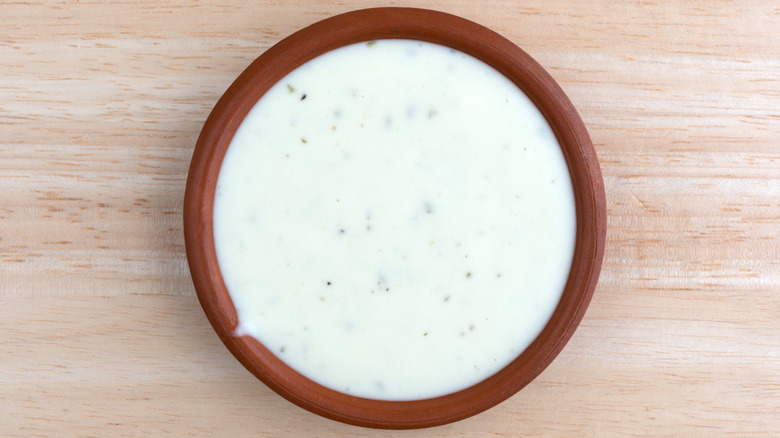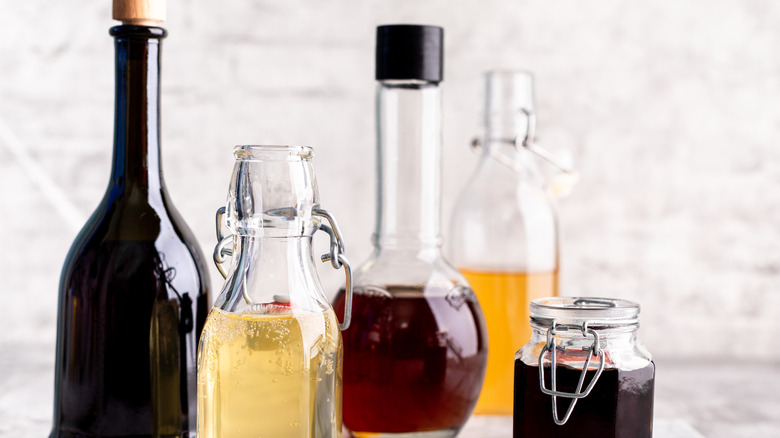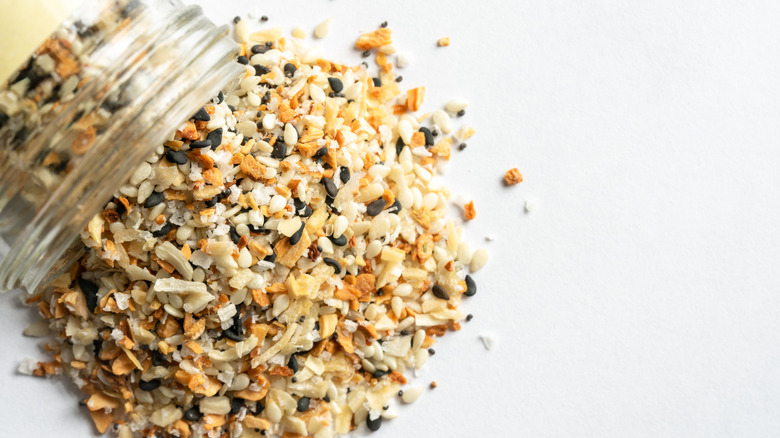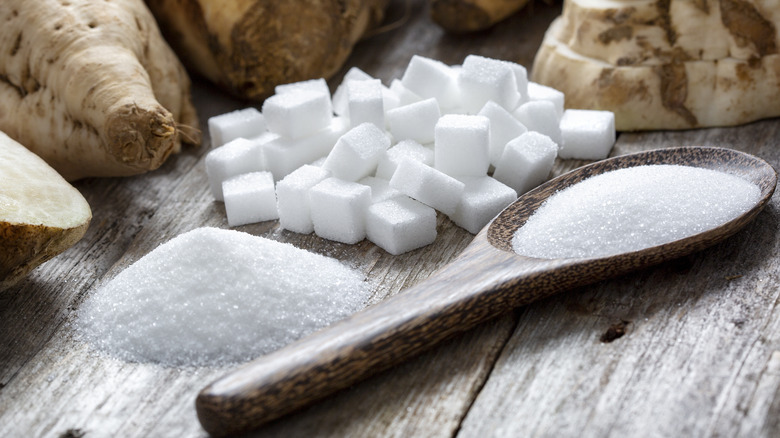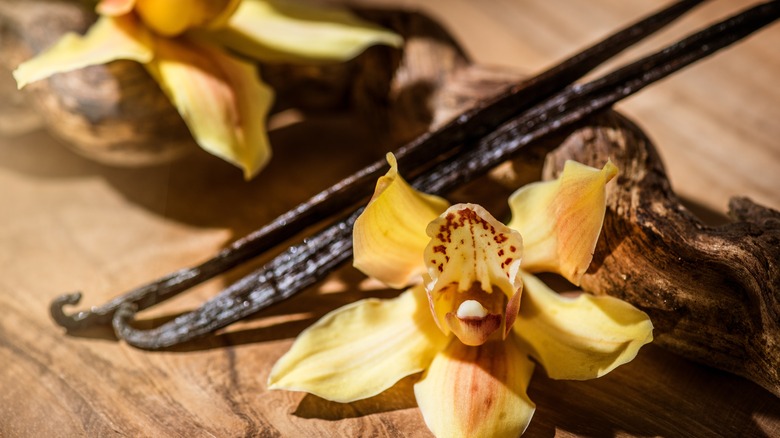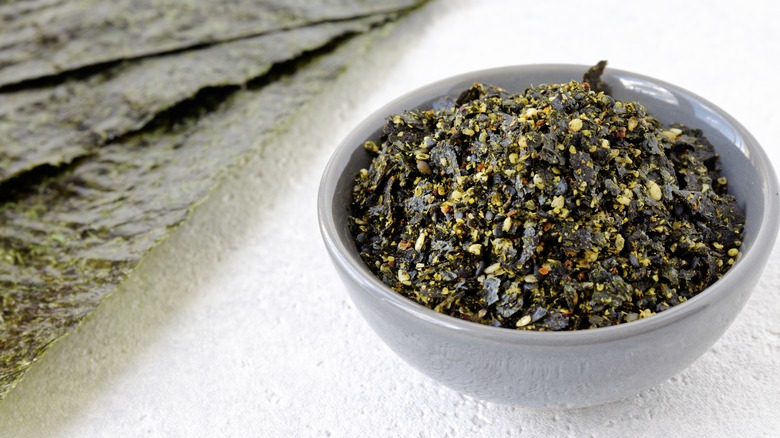16 Ingredients To Elevate Your Roasted Broccoli
If you think about it, roasted broccoli might just be one of the most versatile side dishes out there. First, there's the fact that you can buy broccoli whole, pre-cut, or frozen for ultimate convenience. Then consider that it can be oven-roasted, pan-roasted, or even air fried. Add in how many different entrees roasted broccoli pairs with, and you've got a winner.
When you put it in those terms, there's really just one issue: The taste of plain broccoli isn't always a crowd-pleaser. Broccoli certainly gets a bad rap among kids, and even as an adult, flashbacks to your parents using broccoli as a bargaining tool for dessert can make it one of the less desirable veggies.
However, with its bounty of health benefits, it's worth finding ways to make roasted broccoli a can't-miss dish at your dinner table, and that's where these sauces and seasonings come in. Whether you're attempting to make greens more appealing to a picky eater or you're just looking to mix things up, adding ingredients beyond the standard olive oil, garlic, salt, and pepper to roasted broccoli can go a long way in pleasing any palate.
Chili crisp or oil
Chili crisp and chili oil might just be the hottest pantry staples of 2023 (pun intended). They can be used in everything from meat marinades to scrambled eggs to roasted broccoli and more. With a neutral oil as the base, coating your broccoli in chili crisp or oil before roasting will help to keep it from burning in the oven, pan, or air fryer. The red pepper flakes, onion, and garlic within will add not only an extra crunch but also a much-needed zing to your florets.
There are any number of chili crisps on the market, but you can also make your own. The benefit to making your own, of course, is that you can adjust the ingredients to suit your preferred spice level. Either way, consider storing your chili crisp in the refrigerator to maximize flavor over time.
In addition to packing a punch, another distinct benefit to adding chili crisp to roasted broccoli is that it is usually both gluten-free and vegan. As always, be sure to double-check the ingredient list in your recipe or on your chili crisp label to make sure it suits your dietary needs.
Lemon
Packed with heart and digestive health benefits, a little bit of lemon juice or lemon zest can go a long way in taking your roasted broccoli to the next level where both taste and nutrition are concerned. Not only that, but lemons are an ingredient you can almost always have at the ready. Fresh lemons can be stored in the fridge for two to four weeks, and pre-squeezed, pre-packaged lemon juice from the grocery store can help you cut down on prep time. Keep lemons or lemon juice on hand with a bag of frozen florets, and you've got a healthy, easy side dish on even the busiest days.
For lemony roasted broccoli, you can pair lemon zest with olive oil and salt, or you can coat your broccoli in lemon juice for an oil-free option. Be careful not to over-juice your broccoli, though, as too much liquid can result in steamed broccoli instead of roasted broccoli.
Parmesan cheese
This isn't your grandparents' broccoli smothered in cheese sauce (which, let's be honest, is delicious in itself). Parmesan cheese in its many forms — grated, shredded, shaved — is one of the easiest ways to add rich, creamy flavor to roasted broccoli and a bit of sophistication to this otherwise simple side dish. You can even take the sophistication one step further by sprinkling bread crumbs of your choice on top of your cheesy roasted broccoli.
It's important to wait until after the broccoli has been roasted to add the Parmesan cheese, though — otherwise, you'll have a burnt mess on your hands. The silver lining? While you wait for the broccoli to roast, you can nibble on shredded or shaved Parmesan straight out of the bag or container, which everyone knows is the best snack around. You can take this approach even further by adding a can of tomato sauce for a char-roasted broccoli Parmesan entree.
Alfredo sauce
If you thought Alfredo sauce was just for pasta, think again. Coating your broccoli in this comforting classic before roasting adds the flavor, moisture, and texture needed to take basic veggies to the next level. The Parmesan cheese in the sauce will give the broccoli an extra crunchy finish, and the butter and heavy whipping cream base means you can skip the oil and put your Alfredo-adorned florets straight in the oven. Do take care not to over-sauce your broccoli, though, as too much moisture will prevent it from roasting.
Whether you choose to make your own Alfredo sauce from scratch or use a jarred Alfredo sauce, you can adjust the flavor profile and spice level to your liking. Cajun seasoning, fresh herbs, or red pepper flakes all play well with the garlic and Parmesan in Alfredo sauce and can either be stirred into the sauce before roasting or sprinkled on top when your broccoli comes out of the oven. You can even add a splash of sparkling or white wine to the sauce before roasting for a touch of acidity and to lighten up the naturally heavy Alfredo sauce.
Apple cider
A cider glaze made of apple cider, white vinegar, and sugar is the perfect way to bring autumnal warmth to your roasted broccoli. This thick topping is best applied after broccoli has been roasted in the oven with mild-flavored avocado oil and a pinch of salt. The sharp acidity of the vinegar balances out the sweetness of the apple cider and sugar, resulting in a unique yet irresistible flavor profile. Since the broccoli is roasted before the glaze is applied, you can use as much or as little of the glaze as you like without worrying about it compromising how well your broccoli roasts.
Both the taste and texture of cider-glazed roasted broccoli are yours for customizing. A sprinkle of ground allspice would add hints of cinnamon, clove, and nutmeg to the glaze, and ground cardamom would add just a touch of spice. To enhance the crunch, simply chop the nut of your choice and sprinkle it over the broccoli after roasting and glazing.
Cornstarch
When you're roasting broccoli, chances are good that your goal is to add a satisfying crunch to your meal. If a crispy creation is what you're after, the go-to thickening agent, cornstarch, is the ingredient for you. That's right: The powerhouse pantry staple you already know and love for gravies and sauces — and that you might already have on hand — is the perfect way to elevate the texture of your roasted broccoli.
Since cornstarch has a neutral flavor (or no flavor, depending on your taste buds), you can still season your broccoli any way you like without the cornstarch affecting the taste of the final product. To roast broccoli with cornstarch, coat your florets with the oil and seasonings of your choice, toss them with one tablespoon of cornstarch for every pound of broccoli, and roast as you normally would. As cornstarch heats, it gelatinizes, preventing the release of moisture. This keeps the stem and florets of your broccoli from drying out and losing volume while the edges undergo a crisp transformation under heat.
Garlic
Now, garlic might seem like an obvious choice, but we would be remiss to leave a classic garlic roasted broccoli recipe off the list — especially since there are so many ways to incorporate garlic into the dish. The simplest way to roast your broccoli with garlic is to toss your florets with olive oil, salt, pepper, and minced garlic before roasting in the oven. To make things even easier, you can swap garlic powder for minced garlic — just make sure to substitute ½ teaspoon of garlic powder per one large clove of garlic or ⅛ teaspoon of garlic powder per one small clove of garlic to avoid overpowering your broccoli (unless that's what you're going for, of course).
That said, you can also roast the garlic itself and toss as much of it as you like with your broccoli after roasting both separately. You can take your garlic-roasted broccoli another step further by whipping up a quick garlic butter recipe and then coating your broccoli with the fragrant mixture before roasting. No matter which technique you use, roasting your broccoli with garlic will result in a fragrant side dish that can be served alongside pasta, shrimp, steak, and so much more.
Miso
This versatile fermented paste, perhaps most commonly found in soups at Japanese restaurants, might just be the answer to your next dinner dilemma. Depending on how long miso paste has been fermented, it can range from sweet to savory and everything in between. With several types of miso to choose from, you're sure to find the perfect flavor for your palate, whether it be a nutty white miso, an acidic yellow miso, or an extra salty red miso.
When it comes to seasoning roasted broccoli with miso paste, the possibilities are practically endless: You can toss miso paste with honey to give your broccoli a sugary finish after roasting; you can mix miso paste with butter to drizzle over your broccoli after it comes out of the oven; or you can quickly whip up a batch of this miso vinaigrette recipe to coat your broccoli in before roasting. And since miso paste can be stored in the fridge for several months, it's an ingredient you can easily keep in stock for a bold, elevated roasted broccoli dish any night of the week.
Mustard seed
Ah, the mighty mustard seed. A close cousin to broccoli in the Brassicaceae family, mustard seeds are loaded with antioxidants and serve as the base for any type of mustard you can imagine. Of the roughly 40 species of mustard plants, most mustards are typically made from one of three seeds: black, brown, and white or yellow mustard.
To add a mustardy kick to your roasted broccoli, simply toss your florets with olive oil, salt, and mustard seeds. The result is a behind-the-nose pungency that delivers the flavors of broccoli to you with a kick. Of course, if you're short on mustard seeds, you can always use ground mustard instead — just keep in mind that this will alter the taste and texture of the dish; the mustard flavors will be more dispersed, while the crunch of roasted seeds is omitted. The ground mustard you usually find at your local grocery store is typically made from yellow mustard seeds, which are milder than the black mustard seeds the recipe calls for.
Ranch seasoning
If you're a ranch fan, you'll probably agree that there's not much that can't be made better with a dash of the dressing or, in more recent years, a sprinkle of ranch seasoning mix. In 2019, TODAY reported that a whopping 80% of Hidden Valley Ranch seasoning packets are used for dishes other than salads. Seasoned with chives, dill, garlic, onion, parsley, and salt, you can easily make your own ranch powder to make salty snacks like popcorn and pretzels even more savory and to make vegetables like broccoli and cucumber more appealing.
To add a kick of ranch seasoning to your roasted broccoli, first coat your broccoli in the oil of your choice, then toss it with ranch seasoning — measure with your heart! As noted in the recipe, you can also mix ranch seasoning with melted butter and pour it over the broccoli after roasting. In short, there's really no wrong way to add ranch to your next batch of roasted broccoli.
Ritz crackers
This humble snacktime hero saves the day when bland, boring veggies need rescuing. A rich, buttery alternative to breadcrumbs, a cup of crushed Ritz crackers delivers fantastic flavor and tantalizing texture. This small but mighty snack-turned-ingredient comes in several flavors, including everything bagel, garlic butter, a hint of salt, and roasted vegetables. Your Ritz flavor of choice combined with Dijon mustard, garlic, olive oil, and a sprinkle of salt to taste paired with roasted broccoli will have even the pickiest eaters singing their praises.
The most crucial — and perhaps most fun — step to elevate your roasted broccoli is a delicious crumb mixture made from crushing the Ritz. If you have a food processor, you can simply pulse the crackers together with the garlic, stopping occasionally to make sure the crumbs are small enough to stick to the broccoli and big enough to still be crunchy. If you prefer a more manual approach (with fewer dishes to wash), you can always place the crackers in a plastic zip-top bag and use a rolling pin or mallet to break them up. Pro tip: To prevent accidental tears in the bag, cover it with a dish towel before crushing the crackers.
Vinegar
Sprinkling your broccoli with a few splashes of vinegar before roasting can take it from good to great. If you're worried that the vinegar will make your broccoli a little too tangy, there's no need for concern: The acidity cooks down in the oven, and you're left with the unique flavor of the vinegar of your choosing. Balsamic vinegar will give your broccoli a rich, bold flavor with just a hint of sweetness. Sherry vinegar will sweeten up your roasted broccoli too, but in a way that doesn't overpower the dish. And champagne vinegar, red wine vinegar, and white wine vinegar, all of which are made from the same grapes as their respective alcoholic counterparts, will add a slightly fruity finish to any floret.
If you're not quite ready to roast broccoli and vinegar together in the oven, you can always opt for a drizzle of balsamic glaze over top after roasting. Because balsamic glaze is balsamic vinegar that's been cooked down, it's sweeter and much thicker than the vinegar alone. Simply roast your broccoli according to your preferred method and recipe, then cover with homemade or store-bought balsamic glaze to your heart's content.
Everything bagel seasoning
Everything bagel seasoning goes on just about, well, everything — broccoli included. A blend of just five simple seasonings — dried garlic, dried onion, flaky salt, poppy seeds, and sesame seeds — an everything bagel blend can be the difference between boring broccoli and a show-stopping side dish. After swapping chopped broccoli for chopped cauliflower in this everything roasted cauliflower recipe, all you have to do is coat your broccoli with olive oil and garnish with a generous helping of everything bagel seasoning before roasting in the oven.
Everything bagel seasoning seems to be everywhere these days, so it's easy enough to pick up when you're out and about. But since it's made from such common ingredients, it's also easy to make your own everything bagel seasoning at home. Just keep one very important thing in mind when DIYing: Flaky salt is the crunchy key to exceptional everything bagel seasoning, and it makes for pretty exceptional roasted broccoli, too.
Sugar
Sugar plus heat equals caramelization. Caramelization plus broccoli equals delectable. Coating broccoli with a sweetener like molasses or simple syrup before roasting, then turning up the oven temperature to encourage caramelizing, will help your florets develop that wonderfully nutty flavor that comes from caramelization.
Roasting broccoli in sugar will, of course, make it sweeter, so keep that in mind when choosing a sweetener to suit your tastes. If this is your first time, roasting broccoli with sugar, honey, or maple syrup might be your best bet, as these flavors are familiar to most people, so you'll have a general idea of what to expect from the final product.
Not only will broccoli roasted in sugary, syrupy goodness possibly convince your kids to eat their vegetables, but it can actually elevate the nutritional value of the roasted broccoli itself. Broccoli roasts more quickly when cooked at a higher temperature, which reduces the amount of nutrients lost over time. So, it's important to follow Ina Garten's tips for roasted vegetables and watch broccoli roasted with sugar closely in the oven, as sugar is susceptible to burning.
Vanilla bean
While we're on the topic of sweeteners, let's talk about adding vanilla beans to your roasted broccoli. If you're skeptical of this recommendation, don't worry — the vanilla bean is combined with butter. Incorporating vanilla beans into roasted vegetables — especially broccoli — is as easy as vanilla cream pie: All you have to do is add as few or as many vanilla beans as you'd like to a saucepan with a stick of butter and cook on low heat until the butter is melted. Then, coat your broccoli with the vanilla/butter mixture as you normally would with oil, and it's ready to roast.
Vanilla bean can seem like a cost-prohibitive ingredient at first glance; the best-selling vanilla bean on Amazon rings in at nearly $15 for 10 pods, or $1.50 each. Thankfully, when stored in an airtight container in a pantry or cupboard, vanilla beans will stay fresh for up to eight months. Between its shelf life and the fact that vanilla bean butter can liven up any vegetable you're planning to roast, it could be a worthy investment — just make sure you know what to look for when buying the best vanilla beans.
Furikake
Furikake is a Japanese blend of dry ingredients that will add a delightfully salty crunch that can elevate roasted broccoli. Composed primarily of dried seaweed flakes, sesame seeds, and fish flakes, incorporating furikake into your broccoli is as simple as coating broccoli florets in your oil of choice, roasting them in the oven, and sprinkling furikake on top of the broccoli after it is roasted. How much or how little furikake to put on your broccoli is entirely up to you. Since the furikake is added after the broccoli has been roasted, you can always add more if you like.
According to furikake manufacturer Mishima, furikake in Japanese means "sprinkles," which is exactly how you can think of this seasoning that was originally created as a calcium supplement. Although furikake is not quite as readily available as some ingredients for elevating roasted broccoli, you should be able to find it at your nearest Trader Joe's.
